Gosper curve
The Gosper curve, named after Bill Gosper, also known as the Peano-Gosper Curve[1] and the flowsnake (a spoonerism of snowflake), is a space-filling curve whose limit set is rep-7. It is a fractal curve similar in its construction to the dragon curve and the Hilbert curve.
The Gosper curve can also be used for efficient hierarchical hexagonal clustering and indexing.[2]
Lindenmayer system
The Gosper curve can be represented using an L-system with rules as follows:
- Angle: 60°
- Axiom: [math]\displaystyle{ A }[/math]
- Replacement rules:
- [math]\displaystyle{ A \mapsto A-B--B+A++AA+B- }[/math]
- [math]\displaystyle{ B \mapsto +A-BB--B-A++A+B }[/math]
In this case both A and B mean to move forward, + means to turn left 60 degrees and - means to turn right 60 degrees - using a "turtle"-style program such as Logo.
Properties
The space filled by the curve is called the Gosper island. The first few iterations of it are shown below:
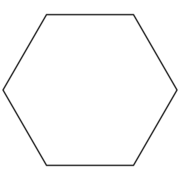
|
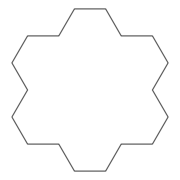
|
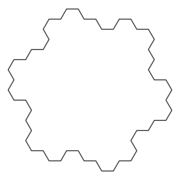
|
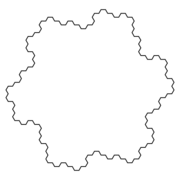
|
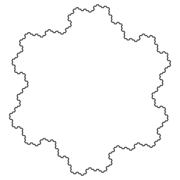
|
The Gosper Island can tile the plane. In fact, seven copies of the Gosper island can be joined to form a shape that is similar, but scaled up by a factor of √7 in all dimensions. As can be seen from the diagram below, performing this operation with an intermediate iteration of the island leads to a scaled-up version of the next iteration. Repeating this process indefinitely produces a tessellation of the plane. The curve itself can likewise be extended to an infinite curve filling the whole plane.

|
240px |
See also
- List of fractals by Hausdorff dimension
- M.C. Escher
References
- ↑ Weisstein, Eric W.. "Peano-Gosper Curve". MathWorld. http://mathworld.wolfram.com/Peano-GosperCurve.html.
- ↑ Uher, Vojtěch; Gajdoš, Petr; Snášel, Václav; Lai, Yu-Chi; Radecký, Michal (28 May 2019). "Hierarchical Hexagonal Clustering and Indexing". Symmetry 11 (6): 731. doi:10.3390/sym11060731.
External links
- NEW GOSPER SPACE FILLING CURVES
- FRACTAL DE GOSPER (in French)
- Gosper Island at Wolfram MathWorld
- Flowsnake by R. William Gosper
 |






